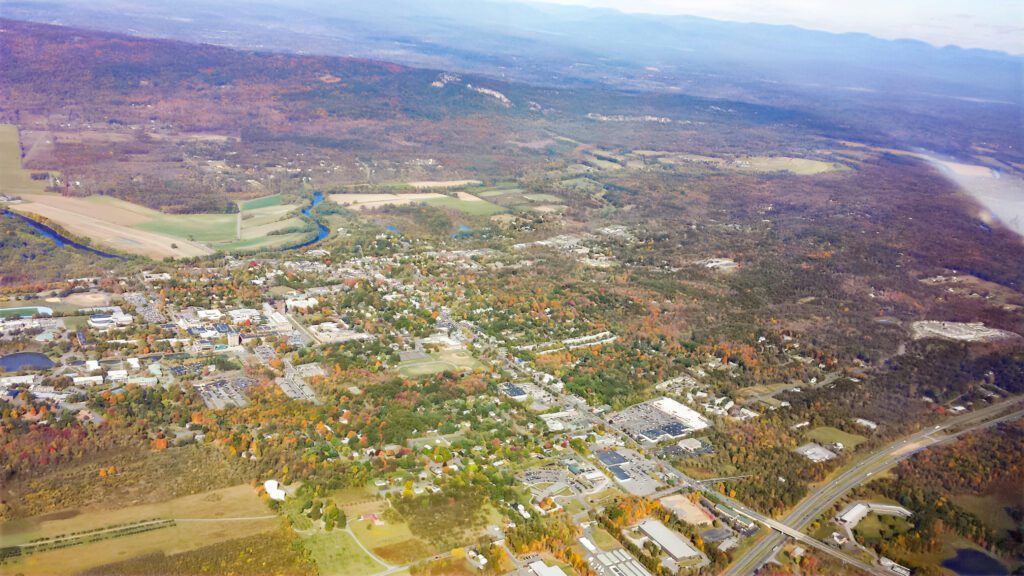New Paltz, New York History
The following is just a short history of New Paltz, New York, the village our DuBois ancestors, along with other French Huegonot refugees, establsihed in 1677. This is their story 1
Mannheim, Prueßen
Before coming to America, the French Huguenot Refugees settled in Mannheim, Prueßen (Prussia, now Germany).
Mannheim became home to many of the French refugees, and among them several families that afterwards removed to America. These families include Louis DuBois, David de Marest, Frederic de vaux, Abraham Hasbroucq, Chrétien Duyou, mathése Blanchan, Meynard Journeay, Thonnet Terrin, Pierre Parmentier, Antoine Crispel, David Usilie, Philippe Casier, Bourgeon Broucard, Simon Le Frebre, Juste Durié, and others, enjoyed the kindness of their german co-religionists and the protection of the good Elector Palatine.
The refugees found much, doubtless, to bind them to the country of their adoption. They were encouraged in the free exercise of their religion. The people and their prince were Calvinists, like themselves. Openings for employment, if not for enrichment in trade, were afforded in the prosperous city, where, a century later, Huguenot merchants and manufacturers were enabled to amass large fortunes. How fondly they remembered the goodly Rhine-land, that the emigrants to America named their home in the wilderness, not from their native province in France, but from the place of their refuge in Germany, calling it “The New Palatinate” [New Paltz].
In spite, however, of all inducements to remain, Louis de Bois and certain of his fellow-refugees determined to remove to the New World; influenced, it may be, by a feeling of insecurity in a country lying upon the border of France, and liable to foreign invasion at any moment.
Their instincts proved correct, as in 1689 Mannheim was severely damaged by the French Army, during the Nine Years’ War.

Aerial view of New Paltz at an altitude of 3500 feet, looking west.2
Table of Contents
New Paltz, New York 1677-1826

It is believed that on the return from rescuing his wife, Catherine and their three children from the Esopus Indians in 1663, Louis DuBois must have been attracted by the fertility of the lowlands along the Wallkill and the hope was born that someday he and a company of friends might start the nucleus of a Huguenot settlement there. But it was not until fourteen years afterwards and the colony of New York had passed from the hands of the Dutch to the English, and his sons, Abraham and Isaac were grown men, that he saw his hopes realized.
Edmund Angross was at that time Governor of New York and there was at Hurley a young Huguenot, Abraham Hasbrouck, who had served with Andross in the English army. Through him a patent for a large tract of land was granted to the “twelve patentees”: Louis DuBois and his two oldest sons, Abraham DuBois and Isaac DuBois, Christian Deyo, Abraham Hasbrouck, Andries LeFevere, Jean Hasbrouck, Pierre Deyo, Louis Bevier, Antoine Crispell, Hugo Frere and Simon LeFevre.
Louis had not forgotten the trouble at the New Village (See my post The Esopus Wars). And so, in May 1677, 5 years before William Penn’s treaty with the Indians and four months before the New Paltz patent was granted by the Governor, the land was duly purchased from the Indians. And this was the price that was paid:40 kettles, 10 large, 30 small; 40 axes; 40 adzes; 40 shirts; 400 fathoms of white net-work; 300 fathoms of black net-work; 60 pairs of stockings, half small sizes; 100 bars of lead; 1 keg of powder; 100 knives; 4 kegs of wine; 40 oars; 40 pieces of “duffel” (heavy woolen cloth); 60 blankets; 100 needles; 100 awls; 1 measure of tobacco; 2 horses, 1 stallion, 1 mare. Besides they were to pay every year a rent to a government official at the redoubt in Esopus five bushels of good winter wheat.3 4
In 1678 the twelve Patentees and their families proceeded to their new home. Upon reaching their destination on the east bank of the Wallkill River, they built simple wood houses, which were replaced by stone dwellings in the early 1700’s.
The people owned the land in common, and by that arrangement the product of their labors went into the common store. For fifty years the ehads of the twelve families met in legislative and executive session to administer the affairs of New Paltz. In 1728, owing to the fact that Dutch inhabitants were increasing in number, the twelve men were elected byy popular vote of all the property owners in teh community. The council was called “DUZINE”, meaning twelve. They apparently exercised rather wide powers, so that their enactments had to be ratified by an Act of Legislature, confirming unto the owners the partition of land made by the “twelve men” dated 1785, and signed by Governor George Clinton. The Duzine continued to function until 1826.5
Citations and Attributes:
- Charles Washington Baird. History of the Huguenot Emigration to America, v. 2. c1885, pages 187-189; Available free of charge at Google Books at this link (Accessed 1 March 2023).
- https://commons.wikimedia.org/wiki/File:New_Paltz_Aerial.jpg#/media/File:New_Paltz_Aerial.jpg
- Cornilia E. DuBois, The Story of the Paltz: a brief history of New Paltz, NY. 1936.
- Ralph Le Fevre, History of New Paltz, New York and its Old Families (From 1678-1820). 1909. Revised 1936.
- The Hasbrouck Family Association, Inc website - Historic Locations (accessed 6 March 2023)
- Louis DuBois House (aka the DuBois Fort) Built 1705. Pcitured circa 1900. By Ralph Le Fevre – History of New Paltz, New York and its old families (from 1678 to 1820): including the Hugenot pioneers and others who settled in New Paltz previous to the revolution (Fort Orange Press, 1903) https://books.google.com/books?id=hIA-AAAAYAAJ&source=gbs_navlinks_s, Public Domain, https://commons.wikimedia.org/w/index.php?curid=93550776
